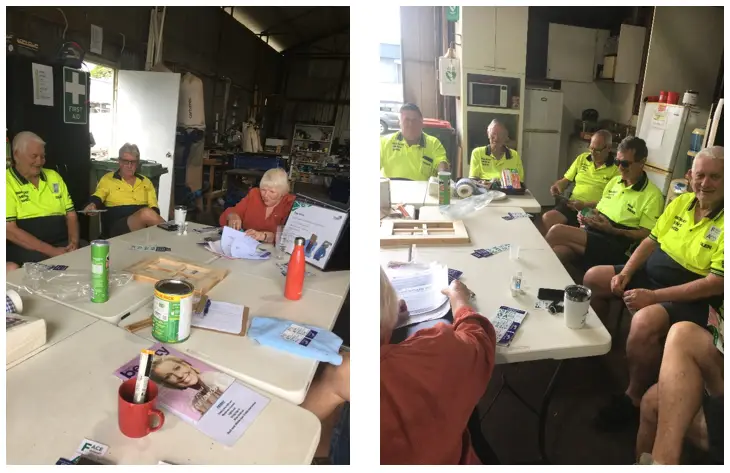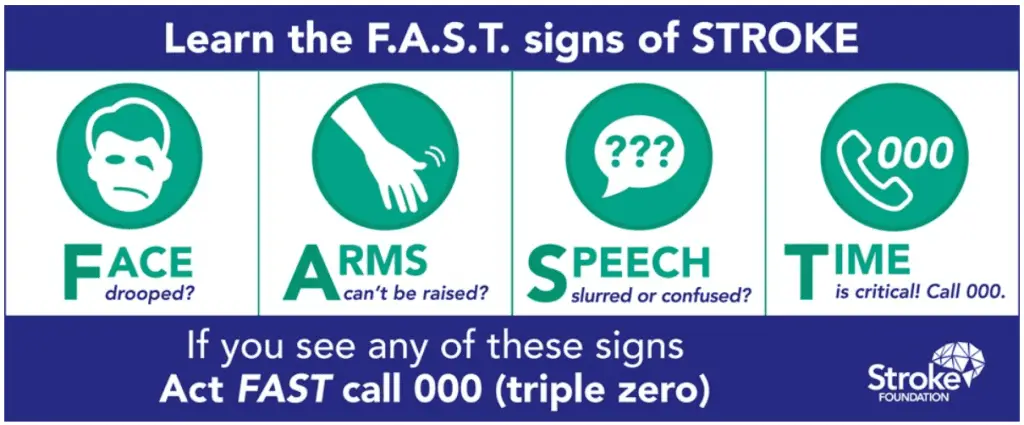31 May 2024
.On Friday 24th May 2024 – The Mackay Men’s Shed Inc welcomed a guest speaker and volunteer from the Stroke Foundation. Anne Jennings visited the shed to provide the team with an entertaining and informative talk on Stroke, recognising the signs and symptoms and what action to take if you suspect that someone may be having a stroke. Anne’s visit inspired me to write a summary of the talk and curate a short video from the information provided.
Feel free to share the article and / or video with friends and loved ones. The more people aware of what a stroke is and how to respond if you suspect that someone is having an event, the better.

Here is a short video summarising the discussion
Recognising and Treating Stroke – A First Responder Guide
Every year, strokes affect millions of lives worldwide, often with devastating consequences. Recognising the signs and symptoms of a stroke promptly is crucial for initiating immediate treatment and improving outcomes. In this guide, we’ll explore how to identify the warning signs of a stroke, including Transient Ischemic Attacks (TIAs) and less obvious symptoms, and discuss the essential first responder steps to take in an emergency situation.
Understanding Stroke:
Before delving into recognising and treating strokes, it’s essential to understand what a stroke is. A stroke occurs when the blood supply to part of the brain is interrupted or reduced, depriving brain tissue of oxygen and nutrients. This can happen due to a blockage (ischemic stroke) or bleeding (hemorrhagic stroke) in the brain.
Recognising the Signs:
The key to recognising a stroke is to think and act FAST:.

- Face:
Ask the person to smile. Does one side of their face droop?
- Arms:
Ask the person to raise both arms. Does one arm drift downward?
- Speech:
Ask the person to repeat a simple phrase. Is their speech slurred or
strange?
- Time:
If you observe any of these signs, it’s time to call emergency services
immediately. Time lost is brain lost.
Look beyond the obvious:
While the FAST acronym is helpful, strokes can
manifest in various ways, and some symptoms may be less apparent. Here are some
additional signs to be aware of:
- Sudden
numbness or weakness, especially on one side of the body
- Confusion,
trouble speaking, or difficulty understanding speech
- Trouble
seeing in one or both eyes
- Sudden
severe headache with no known cause
- Dizziness,
loss of balance, or coordination
It’s crucial to pay attention to these symptoms, especially
when they occur suddenly and without explanation.
Transient Ischemic Attacks (TIAs):
TIAs, often referred to as “mini-strokes,” produce
symptoms similar to those of a stroke but are temporary and typically last for
a few minutes to a few hours. While TIAs don’t usually cause permanent brain
damage, they are warning signs of an impending stroke and should be taken
seriously. Anyone experiencing symptoms of a TIA should seek medical
attention promptly.
Responding to a suspected Stroke Event:
If you suspect someone is having a stroke, follow these basic
steps:
- Call
Emergency Services: Time is of the essence. Don’t wait to see if
symptoms improve; call for help immediately.
- Keep
Calm: Reassure the person experiencing the stroke. Stay calm and
supportive while waiting for help to arrive.
- Note
the Time: Record the time when symptoms first appeared. This
information is crucial for healthcare providers.
- Positioning:
Help the person sit or lie down in a comfortable position, whichever they
prefer. Loosen tight clothing and ensure good airflow.
- Do
Not Give Anything to Eat or Drink: It’s important not to give the
person anything to eat or drink until medical professionals assess them.
- Monitor
Vital Signs: Keep an eye on the person’s breathing, pulse, and level
of consciousness until help arrives.
Conclusion:
Recognising and treating a stroke promptly can make a
significant difference in the outcome for the affected individual. Whether it’s
remembering the FAST acronym or being aware of less obvious symptoms and
signs like those of TIAs, every bit of knowledge can save lives. By acting
quickly, remaining calm, and seeking medical help without delay, we
can help minimize the impact of strokes and improve the chances of a
full recovery for those affected.
For more information visit the Stroke Foundation of Australia